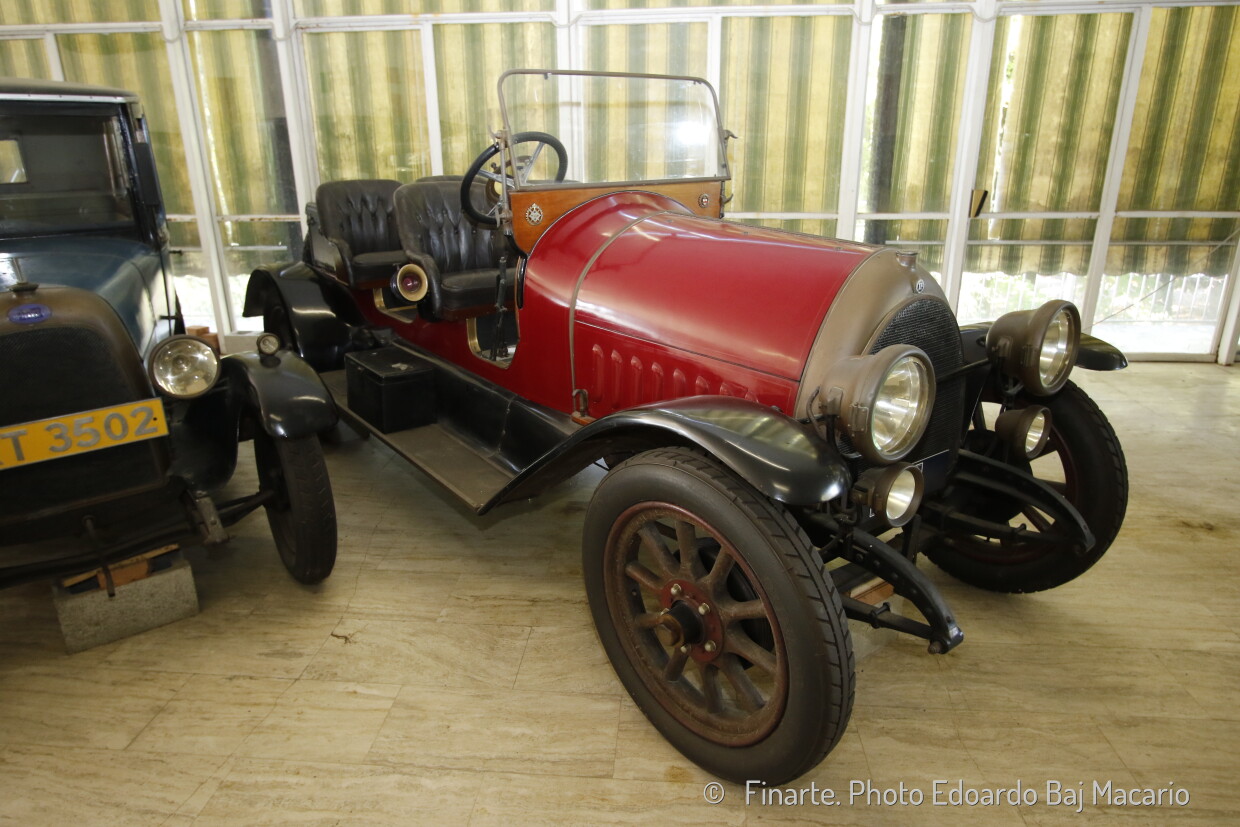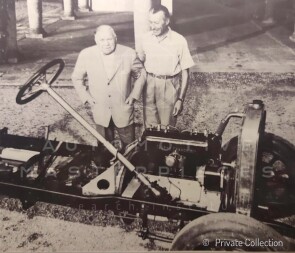
1913 Isotta Fraschini Tipo OC4 25/35 HP
ON/OFF
Why am I an Automotive Masterpiece?
L. Limited edition cars
no. 50 manufactured, 9th built
The Italian car manufacturer Isotta Fraschini was active from 1900 to 1949 and was particularly renowned for producing elegant and innovative automobiles. The Isotta Fraschini 25/35 HP was designed by engineer Giustino Cattaneo, known for patenting front-wheel brakes and for creating the first 8-cylinder in-line engine in 1918. It was a mid-to-upper-level vehicle, comparable to and competing with the FIAT Tipo 3 (aka Fiat 20-30 HP). In the case of Isotta Fraschini, this model was positioned second in the company's catalog lineup. The 25/35 HP, starting with the first OM/OMC type from 1910, became the main model of the company's production and evolved into the OC3 type, produced between 1912 and 1913, and the OC4 type, produced between 1913 and 1914.
Strictly speaking, the OC type is a development of the OMC series, but the extensive reworking qualified it as a separate model. With this model, the outdated chain transmission option was abandoned in favor of the driveshaft transmission. The monoblock engine with side valves, designed and developed by Cattaneo for the OM series, underwent extensive revisions in the OC series, including changes to the engine block casting, valve seats modifications, and replacement of the carburetor. With 4 cylinders and 4940 cc, it could produce 36 hp at 1600 rpm, allowing for a top speed of about 75 km/h. The bare chassis weighed approximately 1100 kg, plus the weight of the bodywork. The OC4 type differs from the OC3 type due to the use of larger rear brakes and the adoption of an electric lighting system, which was installed as standard. The OC4's features included also four-wheel brakes: front operated by hand, rear by pedal. The wheels were detachable wood artillery type. The OC type, another cornerstone of Isotta Fraschini's production in those years, enjoyed widespread success and underwent meticulous updates, reaching an uncommon level of efficiency. It was also the personal vehicle of designer Cattaneo, who would go on to extensively test the OC5 prototype, which, however, never entered production. The 25/35 HP, in the OC3 type, was produced in 72 units in 1912 and 28 units in 1913, for a total of 100 units. In the OC4 type, it was produced in 50 units in 1913 and 50 units in 1914, for another total of 100 units.
The Isotta Fraschini Tipo OC4 25/35 HP, chassis no. 2780, is one of the early examples produced in 1913 (chassis numbers 2771 to 2820); specifically, it is the ninth. The car was presumably registered with the Italian plates issued between 1905 and 1927, which featured two red digits indicating the place of origin, followed by a sequential black number on a white background. According to the records from the Royal Automobile Club of Italy, the car was re-registered on September 10, 1927, under the new registration system, featuring white characters on a black background, with two letters indicating the place of origin and a sequential combination of numbers: in this case, Novara plates “NO 1234”. From these records, it is noted that the car originally had a closed six-seat body. In January 1930, it was converted into a truck. This was not unusual during periods of deep economic crisis (such as the 1929 crash); luxury cars, often seen as relatively outdated, were frequently repurposed for practical use. In 1935, a note on the registration document stated a "reduction in power." The reasons could be varied. Tax reasons: Reduced declared power could lower taxes. Technical reasons: For conversions into uses other than originally intended (e.g., commercial use), a less powerful engine could be more reliable and economical to maintain, and less sensitive to fuel quality. "Political" reasons: In the 1930s, authoritarian regimes tightly regulated luxury vehicles. In Italy, the fascist regime promoted autarky, favoring less powerful and more economical cars. In November 1937, another change was recorded: "change of classification to automotive truck, change in payload capacity" and possibly an alteration from a closed cargo compartment to an open one. Without photographic evidence, these changes can only be inferred. After a period of neglect, the car was discovered in 1961 by a young girl passionate about vintage cars, who saw it along with several other vehicles and many old tools in a garage in Novara, Italy. Recognizing the radiator as belonging to an Isotta Fraschini Tipo 8, she mentioned it to Count Giovanni Lurani, prominent figure in Italian motorsport; co-founder of Scuderia Ambrosiana and 11 times at the Mille Miglia, he also designed record-breaking cars. Lurani purchased the car in November 1961, even if the change of ownership was formally recorded in 1971. At that time, chassis no. 2780 had been converted into a tow truck, complete with a tower crane and hoist on the back. Lurani initially believed the car to be a 1916 model, retaining its original four-cylinder engine, but with a non-original radiator and hood, both from a Type 8. The car's first evaluation was carried out by engineer Guido Cattaneo, at the CABI Cattaneo workshop. He then involved his father, the famous engineer Giustino Cattaneo, who had designed all of the Isotta Fraschini models. He confirmed that the car was from the 1914-1916 period. Lurani believed it to be a Type OC4 from 1915, but in reality, it was produced in 1913. Not only the engine and chassis but many other details were confirmed as original by both Lurani and Cattaneo. These included the axles, suspensions, brakes, dashboard with its instruments, electrical system (complete with four CAV lights, dynamo, and starter), fenders, and windshield. The original engine and gearbox were still functioning. However, only three original Sankey wheels remained; the others had been replaced with heavy, modern wheels due to the vehicle's previous specific use. During World War II, the back of the car had been modified significantly, as it was used as a recovery tractor. In 1963, the car underwent mechanical restoration at the workshop of Giacomo Pozzoni in Robbiate (Lecco). The restoration included the engine, gearbox, clutch, and rear axle. There was an issue with the rear axle, as it had been inverted, probably due to the vehicle's prior utilitarian modifications. Regarding the body, the hood was replaced, and a more appropriate pear-shaped radiator was installed; thereplacement radiator inscribed "Isotta Fraschini New York", was supplied by Henry Austin Clark from the Long Island Automotive Museum. Only the seats remained original, and the vehicle retained this setup, with a large trunk replacing the previous tower crane. The bodywork was then undertaken by Carrozzeria Riva, known for restoring many Isotta Fraschini cars during the 1960s. Riva had a very close relationship with Giovanni Lurani, for whom they bodied the record-breaking "Nibbio" cars. Chassis no. 2780 was rebodied in a style typical of its era, resembling a sports tourer or "torpedo". This open body featured no side doors, with two rows of two seats each—a light, aerodynamic “double phaeton”. The rebuild was carried out with assistance from the late Ing. Cattaneo. The car participated in several international Veteran and Vintage rallies, such as the “Isotta Fraschini Rally” in Stresa on May 26-27, 1973, presented by Erminio Riva. During this meeting the Isotta Fraschini Register was founded. In 1974, the car was auctioned by Christie’s in Monza and sold to the car museum of the “Terme Idroterapiche delle Saline di Miradolo” spa complex, where it was displayed statically for almost 50 years. On November 14, 2022, the car was once again auctioned at “Finarte 2022: Automobili da Collezione.” After sitting idle for a long time, it required restoration but was found in good overall condition. On this occasion, the Isotta Fraschini Tipo OC4 25/35 HP, chassis no. 2780, was sold to a private collection.




